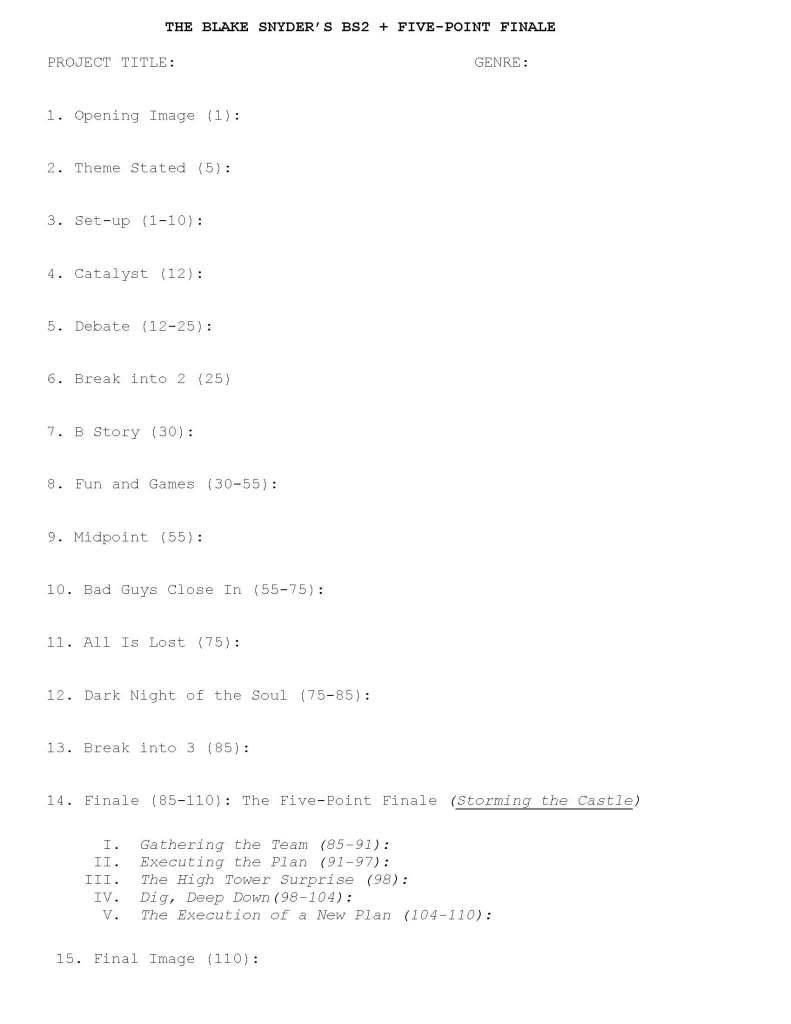 If you thought I was done talking about outlining, than you thought wrong! In my previous post, Power of the Premise Line, we learned how a single, giant sentence with four clauses made up the foundation of story structure: Character -> Constriction, Desire -> Relationship, Resistance -> Adventure, Adventure -> Change. That structure is a sturdy core that will keep you upright through any creative storm.
If you thought I was done talking about outlining, than you thought wrong! In my previous post, Power of the Premise Line, we learned how a single, giant sentence with four clauses made up the foundation of story structure: Character -> Constriction, Desire -> Relationship, Resistance -> Adventure, Adventure -> Change. That structure is a sturdy core that will keep you upright through any creative storm.
But what if we want to go further? What if we wanted a template for our scenes, to know where they ought to take place and what role they must serve in our story? How can we get the pacing perfect and the transitions smooth, just like the stories we see in theaters?
The answer of course takes us back to screenwriting, this time under the guidance of Blake Snyder via Save The Cat. Every story is comprised of three acts: a setup, a confrontation and a resolution. Snyder was tired of getting “lost between the acts”, and so he broke it all down into 14 fundamental story elements he called “beats”.
The Beats
I have a cork board lying against a wall in my living room (I never did bother to hang it up). Pinned to it is several rows of index cards, each of them representing a beat in Samurai of Hyuga Book 4. Written on each card is the beat it represents, as well as a few sentences describing the scene. Doing this forced me to think up the 14 fundamental scenes that comprised the story I wanted to tell. Now that’s extensive outlining!
Of course you don’t need something physical, though Snyder recommends time-consuming methods to slow yourself down. You could do just as well filling out this sheet right here:

That sheet represents 110 pages of a typical screenplay, and where around each beat should be. Obviously, novels and other forms of storytelling will differ in length.
Fill that sheet out before you write the first sentence of Chapter 1. Do that and you’ll be writing with tremendous clarity and confidence, knowing where you’ve got to go and–more importantly–why you’ve got to get there in the first place!
My Personal Beat Sheet Template
I modified the beat sheet in a way that forces me to answer additional questions. Feel free to make use of it yourself!
Opening Image (1)
Set tone for story:
>WHAT TONE AND MOOD IS PORTRAYED?:
>HOW DOES THIS EXEMPLIFY THE “BEFORE” MC?:Theme Stated (5)
Main idea:
>WHAT IS THE THEME OF THIS BOOK? (WHAT IS IT ABOUT?):Set-Up (1-10)
Background for story:
>WHAT A-STORY CHARACTERS ARE INTRODUCED?:
>WHY DOES MC’S LIFE “NEED TO CHANGE”? (STATIS = DEATH):
>WHAT ARE 6 THINGS THAT NEED FIXING?:Catalyst (12)
Change the world, set story in motion:
>SOMETHING BIG HAPPENS:Debate (12-25)
Choices for the protagonist:
>WHAT IS THE COMPLETELY “NEW WORLD” MC MUST ENTER?:
>EXPLAIN MC’S INNER CONFLICT ABOUT MAKING THIS DECISION:Break Into Two (25)
Leave old situation, enter new one:
>WHAT IS THE BIG DECISION MC MAKES?:
>HOW IS THERE A TANGIBLE SEGWAY INTO ACT TWO? (IS IT SMOOTH?):B story (30)
Secondary plot line:
>WHAT IS THE ‘BREATHER’ FROM THE MAIN STORY?:
>WHAT NEW CHARACTERS ARE INTRODUCED?:Fun and Games (30-55)
Promise of the Premise:
>WHAT ARE READERS LOOKING FORWARD TO IN THIS BOOK?:
>WHAT IS THE ‘PROMISE’ OF THE PREMISE?:
>HOW IS THAT ‘PROMISE’ DELIVERED?:Midpoint (55)
Stories A and B cross, false victory or false defeat:
>HOW DOES MC “FALSE PEAK” OR “FALSE COLLAPSE”?:
>HOW ARE THE STAKES RAISED?:Bad Guys Close In (55-75)
Villains regroup and push forward:
>WHAT ARE THE BAD GUYS?:
>HOW ARE THE GOOD GUYS IN “PERFECT SYNC” AGAINST THEM?:
>HOW DO THE BAD GUYS REGATHER WITH HEAVY ARTILLERY?:
>WHAT IS THE INTERNAL DISSENT WITHIN THE GOOD GUYS?:All Is Lost (75)
Mirror Midpoint, false defeat/false victory:
>HOW DOES MC “FALSE DEFEAT” OR “FALSE PEAK”? (OPPOSITE MID):
>HOW DOES THIS SEEM LIKE A TOTAL DEFEAT/COMPLETE VICTORY?:
>WHAT IS THE TANGIBLE/PRIMAL “WHIFF OF DEATH”?:Dark Night of the Soul (75-85)
Why is all this happening?:
>HOW DOES MC FEEL HOPELESS?:
>WHAT DOES MC STRUGGLE TO FIND/ADMIT/REALIZE?:
>WHAT IS THE MOMENT THIS HAPPENS?:Break Into Three (85)
Eureka Moment:
>HOW DO THE B-STORY AND A-STORY MEET?:
>HOW DOES THE B-STORY PROVIDE A SOLUTION TO WIN THE A-STORY?:Finale (85-110)
Solve problems, defeat villains, change world for the better:
>HOW ARE LESSONS LEARNED, APPLIED?:
>HOW IS THE “OLD WORLD” TURNED OVER FOR THE “NEW WORLD”?:
>HOW IS THIS EMOTIONALLY SATISFYING?:Final Image (110)
Mirror of the opening image, lessons learned, how the world has changed:
>HOW IS THIS THE OPPOSITE OF THE OPENING IMAGE?:
The Ten Genres
It wasn’t enough for Snyder to break down story structure into 14 beats! He had seen enough films to be able to categorize almost every movie into one of 10 genres. We’re not talking Biopic, Romantic Comedy and Sci-Fi here. These genres each have a certain character, constriction, desire, relationship, resistance, adventure and change that groups them together. Bet you didn’t know Lethal Weapon was a romance flick!

Monster in the House: A sin is committed, unleashing a supernatural monster that will kill the sinners and spare those who realize what the sin is.
(Jaws, The Exorcist, Friday the 13th)

Out of the Bottle: A wish/curse is granted to serve a need; the spell creates a situation in which some lesson must be learned.
(Bruce Almighty, The Mask, Flubber)

Whydunit: A secret must be uncovered by a detective, forcing him to take a dark turn somewhere–breaking the rules or even his own in order to solve the mystery.
(Chinatown, All the President’s Men, JFK)

Golden Fleece: There is some road to be traveled with signposts signifying the hero’s growth along the way; a team or buddy supports the hero and represents what he lacks; after character development the prize/goal is achieved.
(Wizard of Oz, Star Wars, Back to the Future)

Rites of Passage: There is a life problem that must be dealt with and a “wrong way” to approach that problem (usually running away from it); the solution involves acceptance of a hard truth and that the hero–not the world around him–must change.
(28 Days, Lost Weekend, Ordinary People)

Institutionalized: A group–family, organization, business, etc–faces a choice between towing the company line or rebelling; a sacrifice must be made, leading to joining the system, dismantling it, or leaving it entirely.
(One Flew Over the Cuckoo’s Nest, M*A*S*H, The Godfather)

Buddy Love: “My life changed for having known someone else”; a catalyst character enters the hero’s life and changes him–usually the two start off by hating each other, realize they need each other, and a bunch of conflict, then one big final fight where the two surrender their egos to win.
(Lethal Weapon, E.T., Woman of the Year)

Superhero: “An extraordinary man finds himself in an ordinary world”; he is faced with the plight of being misunderstood or feared for his awesome potential and must change (adapt) in some way to fit in/find a place in the world.
(Gladiator, A Beautiful Mind, X-Men)

Dude with a Problem: The hero is thrusted into a situation they’re ill-equipped to deal with, and must overcome the enemy forces/save their loved one through willpower/being gutsy/the human spirit–ways the audience can relate to and root for.
(Die Hard, Schindler’s List, The Terminator)

The Fool Triumphant: An underdog is pit against some sort of Goliath-type bad guy and is underestimated; but the forces of luck and good nature aid him, and he perserveres to victory.
(Forrest Gump, The Pink Panther, Pee-wee’s Big Adventure)
Conclusion
Samurai of Hyuga Book 4 happens to be in the Golden Fleece genre. I won’t spoil anything here, but if you’ve read the end of Book 3 you can imagine who the “buddy” is and how they possess “something MC lacks”. Creating the beats for SoH Book 4 was a real challenge and one I’m incredibly happy I took on. It helped me transform my “list of vague scenes I want to write” into an unbreakable story structure for me to write inside.
Do yourself a favor, and next time you want to write a story: Beat it Out first!


Again those are great words thanks you for sharing this with us I’m really hyped for the next book now aha I hope you will rest well until next time
Thank you for this, honestly lol I am terrible at this kind of thing by myself.
It looks like the sheets should be links, but they don’t seem to be.